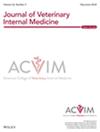Viscoelastic coagulation monitoring parameters in cats with acute arterial thromboembolism
Abstract
Background
Hypercoagulability has been documented in cats with cardiac disease. However, hemostatic parameters, including viscoelastic coagulation monitoring (VCM) have not been reported in cats with arterial thromboembolism (ATE).
Hypothesis/Objectives
Compare VCM parameters in cats with acute cardiogenic ATE and in control cats.
Animals
Sixteen cats with ATE and 30 control cats.
Methods
Multicenter university-based prospective study. Cardiogenic ATE was diagnosed based on physical examination and by ultrasonographically-diagnosed left atrial enlargement. Viscoelastic coagulation monitor analysis, CBC, serum biochemistry profile and coagulation profile were performed at admission in cats with ATE. Analysis from healthy control cats was performed using blood collected by direct venipuncture. Our objective was comparison of VCM parameters clot time (CT), clot formation time (CFT), alpha angle (Angle), maximum clot formation (MCF), amplitude at 10 and 20 minutes (A10 and A20, respectively) and clot lysis index at 30 and 45 minutes (LI30 and LI45, respectively) between ATE and control cats.
Results
Cats with ATE had a decreased angle compared to control cats, with a median (range) of 43° (30-48°) compared to 47° (14-59°; P = .01). The parameters A10, A20 and MCF were decreased in ATE cats compared to control cats with a median (range) of 19 units (8–32) compared to 22 units (6–38), 24.5 units (11-40) compared to 29 units (10-47) and 29.5 units (13-44) compared to 33.5 units (14-53), respectively (P = .01, .01 and .01, respectively). The parameters CT, CFT, LI30 and LI45 were similar between groups (P = .22, .09, .62 and .34, respectively).
Conclusions and Clinical Importance
Cats with cardiogenic ATE cats have VCM parameters consistent with hypocoagulability compared with healthy cats.

 求助内容:
求助内容: 应助结果提醒方式:
应助结果提醒方式:


